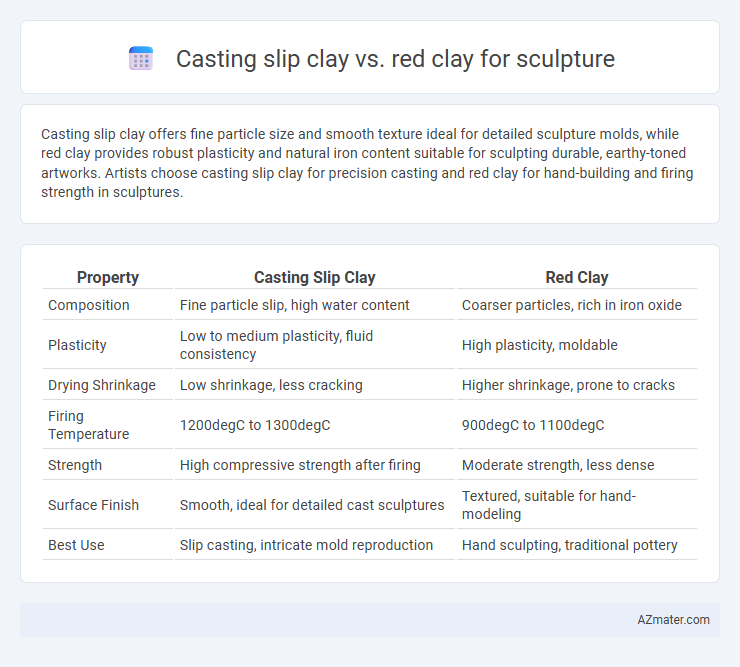Casting slip clay offers fine particle size and smooth texture ideal for detailed sculpture molds, while red clay provides robust plasticity and natural iron content suitable for sculpting durable, earthy-toned artworks. Artists choose casting slip clay for precision casting and red clay for hand-building and firing strength in sculptures.
Table of Comparison
| Property | Casting Slip Clay | Red Clay |
|---|---|---|
| Composition | Fine particle slip, high water content | Coarser particles, rich in iron oxide |
| Plasticity | Low to medium plasticity, fluid consistency | High plasticity, moldable |
| Drying Shrinkage | Low shrinkage, less cracking | Higher shrinkage, prone to cracks |
| Firing Temperature | 1200degC to 1300degC | 900degC to 1100degC |
| Strength | High compressive strength after firing | Moderate strength, less dense |
| Surface Finish | Smooth, ideal for detailed cast sculptures | Textured, suitable for hand-modeling |
| Best Use | Slip casting, intricate mold reproduction | Hand sculpting, traditional pottery |
Introduction to Casting Slip Clay and Red Clay
Casting slip clay features a liquid, fine particle composition ideal for intricate mold casting and detailed ceramic sculpting, offering smooth surface finishes and minimal shrinkage. Red clay, composed of iron-rich natural earth, is prized for its durability, warm reddish-brown hue, and plasticity, making it suitable for hand-building and wheel-throwing techniques. Both materials cater to distinct sculptural needs, with casting slip clay excelling in precision and red clay favored for robust, tactile art forms.
Defining Casting Slip Clay: Properties and Uses
Casting slip clay is a finely ground, liquid clay mixture with high plasticity and low shrinkage, ideal for detailed ceramic sculpture and mold casting. It offers smooth surface finishes and precise replication of molds, making it suitable for producing intricate or thin-walled sculptures. Unlike red clay, which is denser and less fluid, casting slip clay ensures better flowability and uniform drying, reducing cracking risks during the sculpting and firing process.
Red Clay Overview: Composition and Characteristics
Red clay, predominantly composed of iron oxide, kaolinite, and quartz, exhibits a rich reddish hue and fine texture ideal for sculpting detailed forms. Its plasticity allows easy shaping while retaining structural integrity during drying and firing, making it suitable for both hand-building and wheel-throwing techniques. The inherent iron content enhances durability and produces a distinctive warm color after firing, favored in traditional and contemporary ceramic sculptures.
Workability and Handling Differences
Casting slip clay boasts superior fluidity and fine particle size, enabling precise detailing and smooth surface finishes in sculpture molds. Red clay, with its coarser texture and higher plasticity, offers excellent workability for hand-building and sculpting but may result in less detailed casts due to slower drying and potential cracking. Handling casting slip requires careful moisture control to avoid deformation, while red clay benefits from tactile manipulation and retains shape better during the sculpting process.
Sculptural Techniques: Hand-Building vs. Casting
Casting slip clay offers fine particles and high plasticity ideal for smooth, detailed molds in slip casting, enabling precise reproduction of intricate designs. Red clay, being coarser and less fluid, is favored in hand-building techniques such as pinching, coiling, and slab building, providing better grip and structural support during manipulation. Sculptors choose casting slip for uniform shapes through molds, while red clay allows more expressive, tactile hand-crafted forms.
Drying and Shrinkage Comparison
Casting slip clay offers a smoother texture and finer particle size, resulting in slower drying rates and reduced shrinkage compared to red clay. Red clay typically dries faster due to its coarser composition, which can lead to increased cracking and higher shrinkage percentages, often ranging from 5-12%. Sculptors prefer casting slip clay for intricate details and minimal deformation, while red clay is favored for robust, larger forms despite its greater drying challenges.
Surface Finish and Texture Variations
Casting slip clay offers a smooth, fine-grained surface ideal for detailed sculpture work, resulting in a polished finish with minimal textural variation. Red clay, typically coarser with higher iron content, provides a more porous and rustic texture, giving sculptures a natural, earthy appearance with visible grain and slight tonal variations. Surface finish on casting slip clay tends to be more uniform and refined, while red clay allows for expressive texture and pronounced tactile qualities.
Firing Temperatures and Results
Casting slip clay, typically fired between 1828degF and 2345degF (998degC to 1285degC), allows for fine detail and smooth surfaces ideal for delicate sculptures. Red clay, firing around 1832degF to 2012degF (1000degC to 1100degC), tends to produce sturdier, more rustic textures with rich, earthy tones. The higher firing range of casting slip clay results in increased vitrification and strength, while red clay's lower range preserves porosity, affecting final weight and surface finish.
Suitability for Different Sculpture Styles
Casting slip clay offers superior fluidity and fine particle consistency, making it ideal for highly detailed, delicate sculpture styles such as figurines and intricate ornamental pieces. Red clay, known for its coarser texture and higher iron content, suits more robust, expressive works like traditional pottery and rustic sculptures where durability and earthy tones are desired. Selecting between slip and red clay depends heavily on the desired finish, detail precision, and structural strength required for the specific sculpture style.
Choosing the Right Clay for Your Sculpture Project
Casting slip clay offers a fine, smooth texture ideal for detailed molds and precision in sculpture, making it suitable for intricate and delicate projects. Red clay, known for its plasticity and durability, provides better workability and strength, perfect for hand-building and larger sculptures requiring structural integrity. Selecting the right clay depends on project detail and stability needs, with casting slip suited for fine details and red clay favored for robust, tactile creations.

Infographic: Casting slip clay vs Red clay for Sculpture
 azmater.com
azmater.com